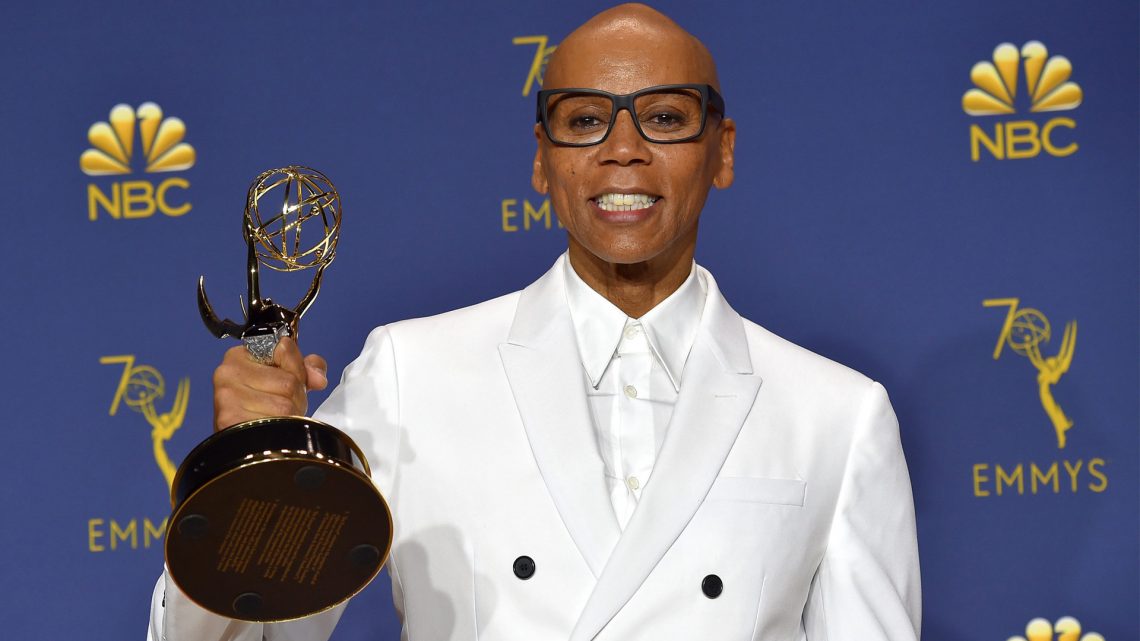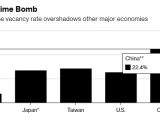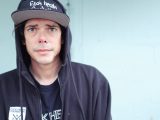
Why We Should All Be Watching More Queer TV
November 9, 2018This article originally appeared on VICE Canada.
If you didn’t have "RuPaul’s Drag Race winning an Emmy” on your rare good news of 2018 bingo card, then you haven’t been paying attention.
The sight of a handful of queens sashaying onto the stage to accept their sparkling trophy—you know, the one that looks like an angel playing beach volleyball—was about as good an omen as they come, but does this type of mainstream validation really mean our TV-scape has changed permanently and for the better?
The answer: maybe and hopefully. Each year, media monitoring organization GLAAD—formerly known as the Gay & Lesbian Alliance Against Defamation—releases the “Where We Are on TV Report,” which analyzes how well the television industry is doing in terms of inclusion and diversity.
For 2018, the results are pretty nice. I don’t mean “nice” like people in Hollywood are finally wholly inclusive and now the whole world is going to live harmoniously as a result, but more like the “nice” in the way that our present spread of television options is getting closer to resembling an actual buffet as opposed to row upon row of bland, mass-produced cafeteria slop.
In other words, TV is more exciting and diverse than ever—which is cool.
According to GLAAD, out of 857 regular characters expected to appear on broadcast scripted primetime television in the 2018-2019 season, 8.8 percent were identified as LGBTQ—an improvement on last year’s 6.4 percent. Of these characters, 50 percent were identified as people of color.
And while these findings are definitely encouraging, there are still some groups who aren’t getting enough glitter time. Women still only make up 43 percent of all characters (even though they compromise about 51 percent of the American population) while characters disabilities chalked up a measly 2.1 percent—a vast underrepresentation considering an estimated 12.6 percent of Americans have a disability.
So just how excited or bummed should we be about these findings? Michael Venus—a former cast member of the world’s first all-LGBTQ sketch comedy series, the House of Venus Show, and current host of OUTtv’s Never Apart TV—sat down with VICE to talk about queer TV going mainstream, what Drag Race backlash means for its future, and whether or not it’s problematic for straight actors to play queer characters.
VICE: This year’s GLAAD report shows a record number of queer characters on TV—8.8 percent. How satisfied are you with this amount of representation? But also, how satisfied are you with the overall quality of the characters. I mean, just because these characters exist doesn’t mean they’re necessarily accurate or of substance.
Michael Venus: As time goes on, I’m happy to see there is more representation, though I’d love to see even more. I don’t want to say that there have always been queer people on TV—I mean there has, but they haven’t necessarily been out—but in the last 25-30 years it’s slowly been trickling to get full representation. Queers make up ten percent of the population, so to have 8.8 percent represented, well, let’s make it a full ten, and continue to move forward that way. Queers are everywhere, which is awesome, but you know, I live in an urban center, which is a bit of a bubble. Like for people who don’t live in big cities—who don’t see queer people around them in real life—it’s very, very important to see people like yourself represented on television. We have a long way to go.
Do you have a favorite show right now?
I’m very fond of Pose on FX. It takes place the ‘80s, in Harlem and in Brooklyn, during all the vogue ball scenes, and that’s an era that I’m super fond of. So they have a lot of trans characters, people of color, different queers that are on the show as well as behind the scenes writing, so it’s really awesome from the bits that I’ve seen. I’m really eager to see more of that show.
The other thing I wonder is if 8.8 percent of characters on TV are queer, then what part of that 8.8 percent is being portrayed by straight actors? And does that compromise things at all?
You know, that’s a touchy subject for a lot of queer and trans actors. It’s not a black-and-white answer. In some ways, yeah, because we’re underrepresented, we need to have queer actors and trans actors playing those roles. But at the same time, when you’re an actor… well it’s tricky. I see both sides of it. If you’re an out-gay or an out-trans or a queer actor, it’s often a lot harder for you to land cisgender or heteronormative roles, so for that reason, it’s important that the queer roles available are filled by queer people. But, at the same time, an actor should be able to pull off a different role. There’s gray area. What do you think?
I don’t know how much it is my place to comment on stuff like this because, well, I’m not an actor, and I’m also a straight person. But I do think there’s something kind of magical about transcending your own identity through the practice of acting. On the other hand, as a straight person, you wouldn’t want to be the one to inauthenticate a character because, you know, you’re not bringing the relevant life experience to a role that a queer person could.
One hundred percent. You know, we’ve seen straight actors playing queer characters quite a bit. Even way back when in the ‘70s, in that film Myra Breckinridge where Raquel Welch played a trans person. And there was The World According to Garp where Robin Williams played a transgender woman. So those roles out there, which are good, but there are a lot of brilliant transgender actors and actresses out there who should get those roles.
Are there any types of queer representation on TV that you’re tired of seeing? Any tropes or narrative arcs that are overplayed?
I thought about this a lot in the 2000s, especially in relation to Queer Eye for the Straight Guy and the Hollywood version of The Birdcage. On one hand, back then I was super excited to see gay men on television. But they were playing these queeny, nelly characters—which are what a lot of homophobic people stereotype gays as. And so when I saw these characters I was like, oh, people are laughing at us, they’re laughing at that archetype. But at the same time, I love when people are queeny and nelly, and that’s a real portion of queer people. So no, in this day and age, I don’t have any dislike for any of the queer characters I’m seeing.
And are there specific types of queer representation you want to see more of? Or specific identities that you think aren’t receiving their fair share of the spotlight?
Oh for sure. I mean we’re just touching the tip of the iceberg when it comes to seeing transgendered people on television. I would love to see more people of color, Indigenous people, and two-spirited people. I would love to see more butch lesbians. I would love to hear more Canadian stories. More about the underdog. More about people who really have to fight. I’m really lucky to be a part of Never Apart TV, and we’re giving voices to a lot of Canadian artists, a lot of queer transgender people of color, Indigenous folks, and artists from all over North America.
That’s great, and you’ve been a part of OutTV—the world's first LGBTQ television network —for a really long time…
I have, and it’s really exciting. Right now on Never Apart TV, which is on OUTtv and OUTtvGO, we’re showcasing season two and we’re working rapidly to finish season 3 because there’s such a demand. The ratings are doing really well, both online and on television, and the network keeps expanding territory. So our show is going into South Africa, New Zealand, Australia, the UK, the States, and on and on!
Amazing.
Yes, because Canadians are not represented a whole lot, and as artists you have to move to Berlin or the US if your goal is to become famous or a rock star. So it’s cool to celebrate being queer and Canadian. As far as my involvement with OUTtv goes, I was involved with the world’s first, all-gay sketch comedy show, the House of Venus Show, and we did three seasons in the mid 2000s and that aired on OUTtv but it also re-sold all over the world. And that was at a time when there just wasn’t gay TV. We had Will and Grace and Ellen and that was it. We’ve come a long way, baby!
True! I wonder—because you brought up Canadian queer identity—is there anything that distinguishes Canadian queer identity from American, or North American queerness more broadly?
Well, we do share a lot of similarities with our American counterparts, and a lot of our sense of humor with our British comrades. But Canada has been known to breed a lot of hilarity. You know, from Kids in the Hall to Second City Television. There are also so many mainstream, Hollywood actors from Canada. But a lot of people don’t realize they’re even Canadian because they’re just under the big American... thing. But I really do feel that Canadians, and especially queer Canadians, have their very own unique sense of humor. Do I believe that we’re being represented enough and that we’re celebrating our own? No. And again, with Never Apart, we’re really trying to elevate not just queer people internationally, but Canadians especially.
Two of the most popular shows that brand themselves as queer today are RuPaul’s Drag Race and Queer Eye. But I’ve heard people say that Drag Race is like the queer equivalent of America’s Next Top Model, while Queer Eye is kind of like What Not To Wear, and that both of these shows—albeit more inclusive than their hetero counterparts—present a bit of a skewed perspective of queer culture due to their polished and glamours, male-centric cast. What do you think about this? Are popular shows like Drag Race and Queer Eye doing enough in terms of inclusivity?
You know, that’s not really up to me to say if they’re doing enough. The fact that they’re on TV, super popular, reaching a very broad audience, creating dialogue, creating change—these are all positive things. These shows aren’t going to be perfect but they are opening the door for other shows and for other representations to be revealed. It’s always very easy, especially from behind your computer, to troll and to say negative stuff. And even if there are elements of truth in the critiques, I grew up in an era where there weren’t gay people on TV. And the fact that these shows are doing so well, hitting the mainstream, is very significant. I hope these shows are ushering in a new era of representation for many people. There are so many marginalized and underrepresented communities, but we’re getting there, so we have to celebrate our strides and achievements. I think both Drag Race and Queer Eye are really great, and are doing something very positive on your planet.
Your show Never Apart on OUTtv is about bringing queer art and queer artists into the mainstream, and so I’m wondering, what specifically can queer artists bring to the art world that maybe a straight person could not?
We’ve been hearing straight stories forever, and so we’re sort of brainwashed to want to live out those stories ourselves. Queers have to navigate through our own world, drumming to our own beat and trusting our instincts, and obviously with the internet it’s changing, but it’s really, really important that visibility happens. Especially in the art world because artists are almost like fortune tellers in terms of what is next to come. As queers, we almost have these magical powers in terms of creating art and making things fantastic and being visionaries. The puritan Christian happenings that suffocated a lot of different cultures—like hundreds of years ago—are just starting to let up, and so we’re just starting to get our voices back. I also believe, not to sound too hokey or hippy-dippy, that we’re all reflections of one another, and that everyone can relate to stories and to artists, whether queer or straight or whatever.
This reminds me a bit of the argument against labelling movies or TV shows solely in terms of the marginalized groups they represent. As in, women don’t want shows like Orange is the New Black or The Handmaid’s Tale to be known as “women’s television” because even though these programs feature mainly women, they’re for everyone.
For sure.
I mean we don’t call Breaking Bad “men’s TV,” right?
Yeah, and the division between men and women is something we’re still fighting about in society today—especially, and unfortunately, with all this stuff going on in the States with the very conservative, very fascist political stuff. It’s absolutely insane to categorize something as “for men” or “for women.”
It’s funny because I’ve always been a big fan of Orange is the New Black —well mostly the earlier seasons—but I was reading this article about the queerest shows on TV, and Orange is the New Black was pretty close to the top of the list and I thought, oh right, it is super queer. But I had never thought about it as decidedly queer television. It was just a good show about a lot of different people.
Totally. It’s all very subjective, too. I mean, I love Sesame Street. Even as a kid I related to it because there were two men—Bert and Ernie—living together. But that doesn’t mean it’s a “gay show.” I mean, even with RuPaul’s Drag Race, there’s a ton of people who watch that show, but most of them are teenage girls! I mean, a lot of the queens who have been on Drag Race have been on Never Apart, and they say the same thing: Their biggest fans are 14-year-old girls, so what does that say?
That’s something I love about TV—that you can identify with characters who don’t necessarily have the same experience as you. Speaking as somebody who grew up white, middle class, and female, a lot of the characters I read about in books were people who had pretty similar life circumstances as myself. I was one of those people who saw myself reflected back all the time.
And you don’t second-guess that, right? And that’s what happens with a lot of straight, white males. If the world has been practically made for you, you don’t wonder why a woman might be scared walking through a parking lot alone, or why a black person might have a problem with you even if you don’t think you’re being racist. If you haven’t experienced those types of negative things, how would you ever have empathy or be able to understand? And that’s why it’s so important to have varied representation on television, so that people can have empathy and understand—even if they’re a straight, corporate, white male person—that there are other perspectives and stories. Try to look outside what the culture has force fed to you.
I guess my last question, then, would be whether you think the television industry should be focussing on more queer characters breaking into mainstream TV (say, having a stronger queer presence on established network sitcoms) or to have more shows that focus on decidedly queer issues (programs like Drag Race or Queer Eye ). Obviously, it’d be nice to have both of these things, but which avenue do you think has more potential to change the public perception of queer experience?
I think there’s room and demand for both. There are so many stories that need to be told, and like I said, we’re just touching the iceberg here. There are so many possibilities in terms of what could be on television. The networks aren’t what they were 25 years ago. We’ve got Netflix, we’ve got the internet, and so there’s more freedom to explore. And I think that’s in part why shows like Orange is the New Black and RuPaul’s Drag Race may not have started out in the mainstream but have built a mainstream following. Directors and producers and people in the industry are taking note. And how could they not? There really has been a landslide of change in television and film over the past ten-to-15 years, I mean, it’s just crazy. But are we there yet? Absolutely not.
Sign up for our newsletter to get the best of VICE delivered to your inbox daily.
Follow Mica Lemiski on Twitter.


